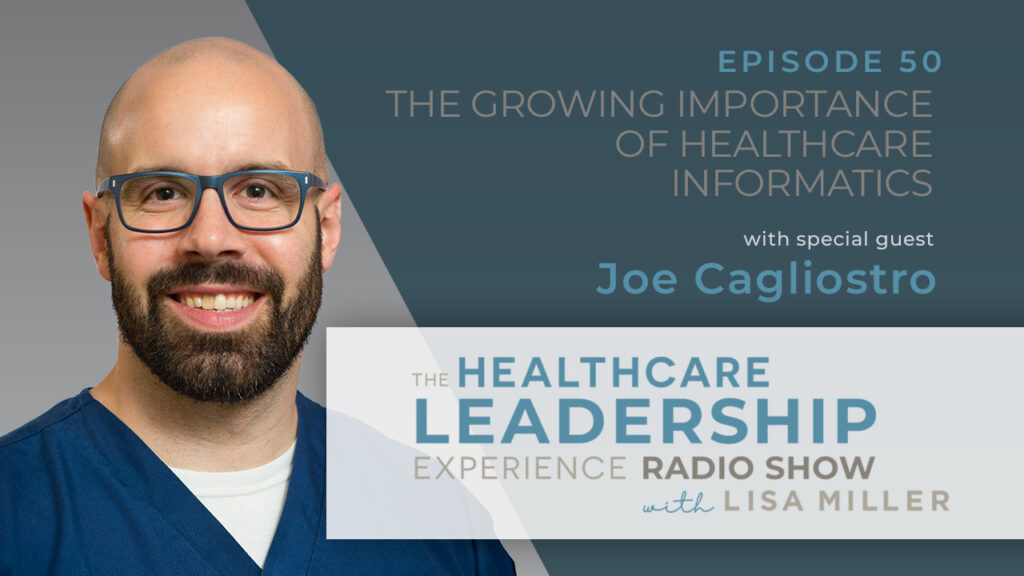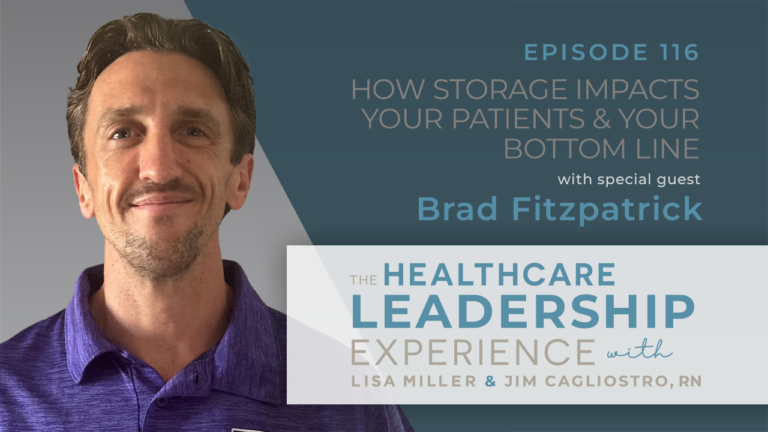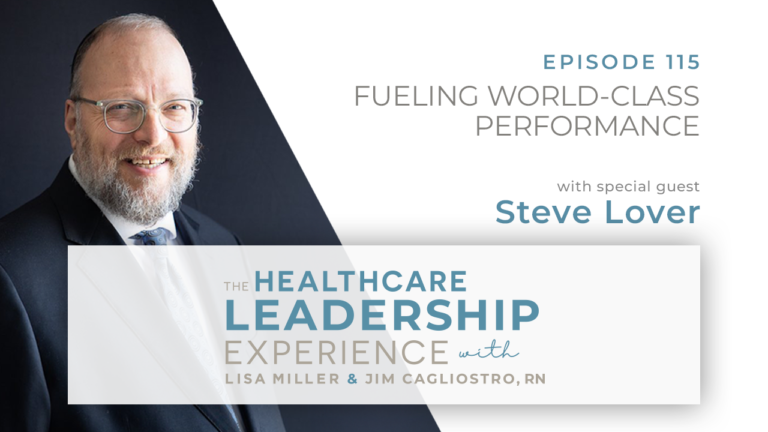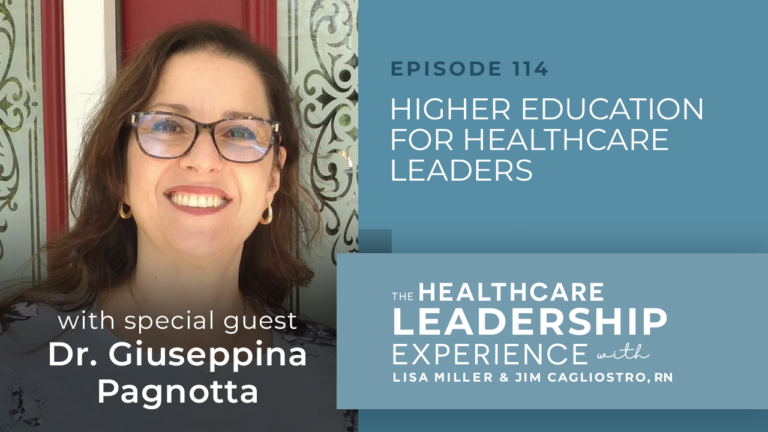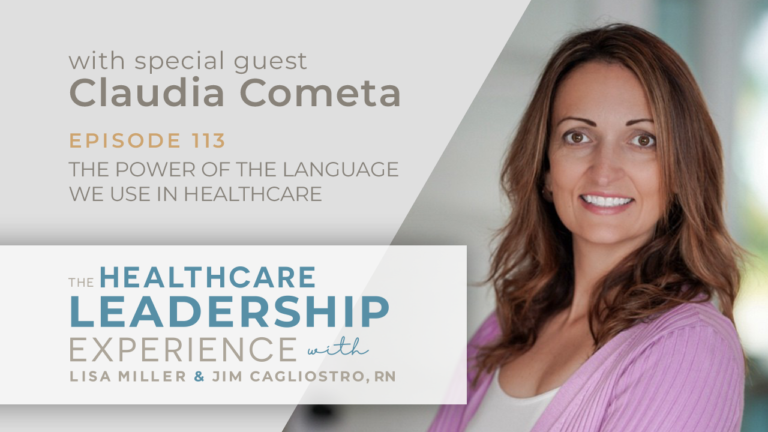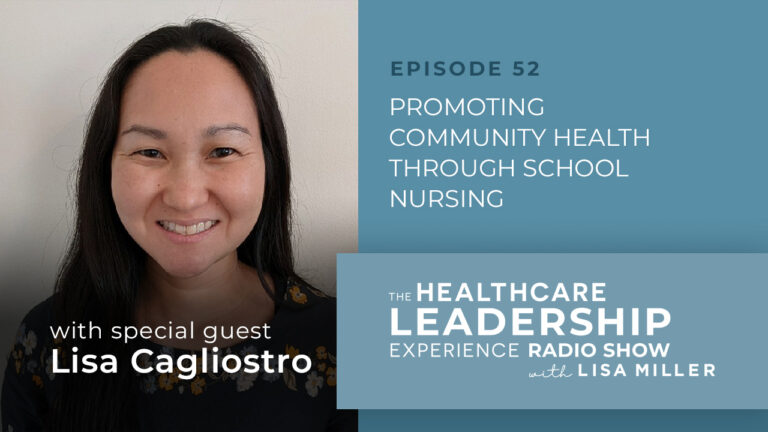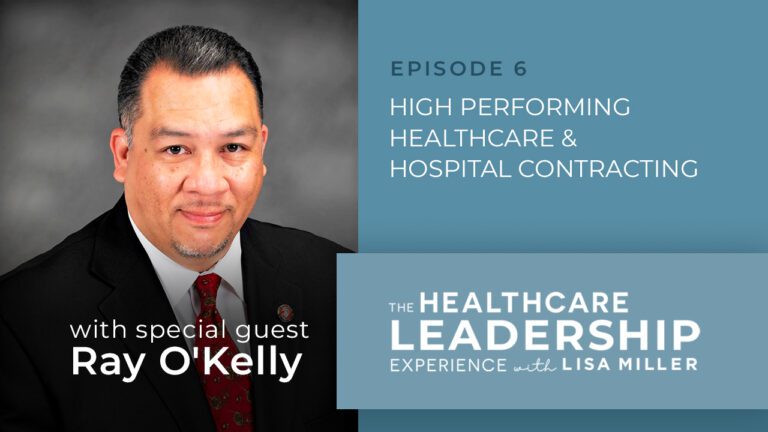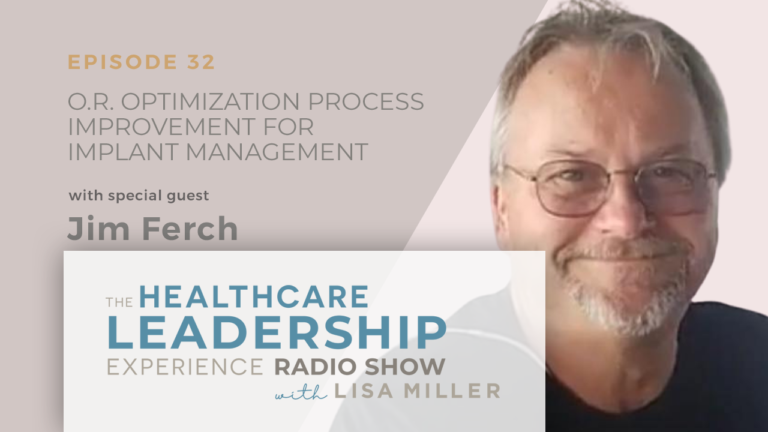In Episode 50 of The Healthcare Leadership Experience Jim Cagliostro is joined by Joe Cagliostro, Informatics Site Manager at Robert Wood Johnson, Barnabas Health, to discuss the impact of informatics on healthcare.
Episode Introduction
Healthcare as a sector has been slow to adopt the technology. Healthcare informatics can help to bridge that gap. In this episode, Jim Cagliostro, VIE’s Clinical Operations Performance Improvement Expert, interviewed Joe Cagliostro to discuss the benefits technology offers healthcare. These benefits include patient safety, Joe’s role in bridging the gap between IT and nursing, virtual resources for novice nurses, and how to encourage staff buy-in.
Show Topics
- The shift to healthcare informatics
- How the ‘’RN tag’’ builds trust between IT and clinical teams
- Lab specimen barcode scanning
- How healthcare informatics enhances EMR processes
- An on-call virtual resource for smaller community hospitals
- The challenge of keeping patient information secure
- Encouraging staff buy-in to technology
02:33 The shift to healthcare informatics
Joe outlined his career history and the need to learn a whole new language in nursing informatics.
“And as I took on more of those responsibilities, it really developed my interest in the IT side of healthcare in the informatic side of nursing. And an opportunity came up, a job opening within the RWJBarnabas system. And I applied for it after finding out a little bit more. And I started working in that role about a year and a half ago. Now it was eye opening to me because when I was in nursing education, I knew everything about IT because I knew how to double click a mouse, or I knew what an icon was, but then coming into the true IT department, it was like I had to learn a whole new language. Now keep in mind. My MSN was in nursing education. Now it is incredible to see the number of programs out there foran MSN in nursing informatics. It was a whole new language. It was a whole new world that I had to learn working in this clinical informatics role.’’
07:00 How the ‘’RN tag’’ builds trust between IT and clinical teams
Joe explained how his experience of the challenges nurses face helps to establish relationships more quickly.
“I know when I first came into the role, a lot of my coworkers that I was training with, they said, you know what, Joe, in addition to your ID badge, make sure you hold on to your RN tag that hangs underneath your badge. You want people to know as you’re rounding that you are indeed a nurse because the nurses, although they’ll respect anyone they interact with, they have just a higher degree of appreciation for someone who knows the struggle. Someone who knows the challenges, the time constraints, the barriers, especially since my role is working specifically with the electronic medical record. When they know that I know the struggles that they have with the EMR, they’re more likely to give an open ear. They’re more likely to say, Hey, you know what? He knows what it’s like. I’m going to listen to what he has to say, because I know a little bit of their struggles. The challenges that come up during any given shift for the nurse, for the physician, the provider, and part of that experience helps me in translating things from the clinician to the analyst and vice versa, right? The clinician has a problem. I have to relay that to the analyst in a way that they’ll understand, or the analyst wants to present a solution, or they have a problem. I need to explain that to the clinician in a way that they can understand.”
11:22 Lab specimen barcode scanning
Joe gave an example of how his role helped analysts to understand workflow on the frontline of healthcare.
“A little while ago, one of our last hospitals in our system to go live with lab specimen barcode scanning. So really it’s been in the system for a while now, but there was one hospital that we’re really trying to catch up to speed. And the analyst, they had the ability to troubleshoot the mapping and the networking of the printers. And if we wanted the lab specimen labels to print to the lab between certain hours, but then to the floor at other hours, I mean, this is above and beyond my knowledge, as far as how they configure all those settings between, well, what’s the IP address and naming that printer so that it can be communicated with once the order is put in by the physician. That’s above and beyond me, at least at this point. But once I went through the process, I had a little bit better understanding. Whereas those analysts trying to get this system up and running for the nurses didn’t understand the workflow that the nurses had to follow. Right. They had to go to their supply room, get their specimen tubes, their alcohol preps, their tourniquets. Then they had to go to the nurse’s station and were moving towards printers installed on our portable works stations, our portable WOWs, but not quite there yet. So they have to go to the nurse’s station, get the label printed, but the analyst didn’t understand this back and forth, then this WOW being brought to the room. But the nurse, and infection prevention is another factor, going in one time with everything that you need. And I had to explain that workflow to the analyst.”
14:38 How healthcare informatics enhances EMR processes
Joe highlighted the benefits healthcare informatics can bring to patient care and safety.
“And so one of these organizations that ensures we’re providing safe care was looking at our process for medication entry into our EMR. And what we did was we had to have myself as well as a provider, someone from the lab, someone from pharmacy, someone from quality and to test our EMR to make sure the appropriate safety alerts pop up. Right. And as we talk about moving into the future, it’s almost like every day, every month, every year, more and more of these safety nets are built. For example, we were testing out if I order certain medication for a patient over the age of let’s say 79, do I get an age related alert saying this patient might be at risk? If the provider’s ordering one beta blocker, but the patient already is on another beta blocker, do I get an alert saying duplicate orders, contraindication, this is not safe for the patient? Along with auto crosschecking meds, Hey, this med might be harmful to the kidneys. What’s the renal function, right? So all these alerts that are popping up and the great thing about EMRs and there’s a lot of homemade ones, but there are some larger ones that really many healthcare systems are taking part of, they’re very customizable. And we say, look, we’re noticing this patient’s getting a med order they shouldn’t have gotten. Our analysts can build that.”
18:00 An on-call virtual resource for smaller community hospitals
Joe said that virtual support for the inpatient setting is vital to the future of healthcare in smaller communities.
“One more thing I will share quickly, smaller community hospitals that have a higher turnover rate, many brand new novice nurses. It’s a network of experience. Even some nurses that we’re planning on retiring have joined this network. And we’re trying out this almost on call experienced nurse system where our new nurses at our smaller hospitals can almost have this on call nurse, this virtual resource nurse that they have a patient that is not as stable as they once were. They’re concerned. They can tap into these nurses and have them provide their recommendations, their guidance, their support, when we don’t physically have the ability to support nurses at a physical location for whatever reason. So that’s one way I see that can become a very big thing in the next 10 to 20 years.”
19:53 The challenge of keeping patient information secure
Joe said that maintaining the privacy of patient information in the face of rapid growth is a challenge for healthcare. e
“For example, you have a provider, you have a director, a manager, somebody wants to bring in a new application. What we have to do is we have to make sure that it is secure enough to handle our patient information. Back in the day, much of patient information, secure patient information was held on older systems that used physical hardware servers, right? And that’s very quickly moving to cloud-based servers. And when you move it to the cloud, obviously it’s a whole other method of security. And so even before something’s brought into our local hospital, our healthcare system, it has to go through so many checks, so many verifications that it indeed can secure our patient information. So that’s a huge thing. Just being able to provide the highest level of protection when dealing with personal and sensitive healthcare information. Cost is always a factor.”
20:47 Encouraging staff buy-in to technology
Joe shared an example of how he overcame resistance to change
“One specific example, I was at a IV infusion pump training class, as we’re moving to a new EMR throughout our system and we were teaching them the process of integrating our pumps into that new EMR. Some of the staff were saying, well, man, to associate the pump, now I got to bring my scanner over here to the patient’s wristband and then to the pump. And it is, I told them, it’s going to slow you down at first because it’s new. But to imagine when you associate that pump and scan that patient, that drug, that pump now, instead of having to manually input the name of the drug, the dose, the concentration, the rate, the volume, you scan that bag, that patient, that pump, it pulls it right in. So before you know it, and it becomes muscle memory now, not to the point where we’re not thinking about it, but there are safety measures built into these pumps as well. This will in fact, speed up your time. It’s ultimately going to make your job easier, quicker, but at the same time, safer and more efficient for the patient. So that’s just one specific example in regards to staff buy-in.”
Show Links
📱 Connect with Jim Cagliostro on LinkedIn
🖥 Check out VIE Healthcare Consulting
You’ll also hear:
- How nursing informatics bridges the gap between IT and the clinical world of healthcare, nursing and medicine.
- When it comes to IT and nursing, communication and teamwork is equally as important as the caregiver/care provider relationship is for patient care.
- A practical example of nursing informatics assisting in patient care. “When you’re trying to print out a label for blood work and it’s not going to the printer, then you have a problem. And then it’s people like you that are making that work behind the scenes….I know at the bedside, we’re not even thinking about these issues.’’
- Why healthcare informatics is essential to improving patient safety and outcomes by providing better resources and accessibility. “What good is the resource if you can’t get it into the hands of the clinicians, into the hands of the patients, right?”
- How the pandemic has moved the healthcare IT sector forward by at least ten years.
- The one quote about change that helps to understand staff resistance to advances in healthcare technology – and why the more rapid the change, the harder it becomes to encourage staff buy-in.
- Why “turning it off and turn it back on again” really can correct malfunctioning tech equipment. “Maybe 65, 70% of the time, if you’re dealing with malfunction equipment, that is what you should try to do. And that has solved the problem 70% of the time. So when in doubt, turn it off and turn it back on again.”
What To Do Next:
- Subscribe to The Cost Advantage for Healthcare Leaders and receive a special report on 15 Effective Cost Savings Strategies.
- Learn more about the simple 3 step process to work with us.
- If you are interested in learning more, the quickest way to get your questions answered is to speak with one of our margin improvement experts. Schedule a call with our team.
Episode Transcripts
CLICK HERE TO DOWNLOAD THE PDF TRANSCRIPT
CLICK HERE TO OPEN THE TRANSCRIPT
Introduction (00:01):
Welcome to the Healthcare Leadership Experience Radio Show with your host Lisa Miller. This week, the Healthcare Leadership Experience will be hosted by Jim Cagliostro. Jim brings over a decade of critical care nursing experience at highly regarded medical facilities across three states. During his time at the bedside, he observed both the good and bad of hospital operations in several regions, giving him a unique insight and perspective on the healthcare industry.
Jim has been a part of the VIE Healthcare team since 2018, where he’s made patient care and the patient experience a top priority. He has observed that keeping patients at the center of healthcare can transform the patient experience and lead to success for any health system, big or small. Here’s your host Jim Cagliostro.
Jim Cagliostro (00:50):
Hi, this is Jim Cagliostro and you’re listening to The Healthcare Leadership Experience Radio Show on Healthcare NOW Radio. Today’s guest is Joe Cagliostro. You may notice we share a last name. That’s because he is my brother. Joe is an informatics site manager for Robert Wood Johnson, Barnabas Health in New Jersey. He got his BSN from Messiah College and his Master of Science in Nursing, in Nursing Education from Liberty University. So today we’re excited to jump into the world of nursing informatics. Joe, welcome. And thanks for joining us.
Joe Cagliostro (01:24):
It’s a pleasure to be here. Thanks for the opportunity.
Jim Cagliostro (01:27):
Definitely. So, first question, tell our listeners, tell me a little more about yourself, your career, and specifically how you ended up working in nursing informatics.
Joe Cagliostro (01:37):
Sure. So a little bit of background. I started out doing a night shift on a med surge telemetry unit at a small community hospital. And as I was working there, many of my coworkers were going back to school to become nurse practitioners. And I didn’t quite have an interest in going that direction. And during that time, there were so many nursing programs, even online programs, but the majority of the accredited programs were for nurse practitioners, for nursing management, leadership and education. Those are the ones that I saw and out of all those programs out there, I gravitated more towards education. Got my degree in nursing education then I worked in nursing education at that same community hospital for about eight years. While I was in that role, many of my coworkers in that department kind of came to me as the IT guru in the nursing education department.
Joe Cagliostro (02:33):
And as I took on more of those responsibilities, it really developed my interest in the IT side of healthcare in the informatic side of nursing. And an opportunity came up, a job opening within the RWJBarnabas System. And I applied for it after finding out a little bit more. And I started working in that role about a year and a half ago. Now it was eye opening to me because when I was in nursing education, I knew everything about IT because I knew how to double click a mouse, or I knew what an icon was, but then coming into the true IT department, it was like I had to learn a whole new language. Now keep in mind. My MSN was in nursing education. Now it is incredible to see the number of programs out there for an MSN in nursing informatics. It was a whole new language. It was a whole new world that I had to learn working in this clinical informatics role.
Joe Cagliostro (03:34):
So really there’s so many different directions that one could go, whether they want to be on the analyst side, whether one wants to be more on the clinical side of informatics. As you mentioned, my title is informatic site manager. There was a number of years ago, a merger within our company, and I actually prefer the title, because I really think it defines the role that I have, the title that my counterparts on the other side of the system have rather than informatic site manager, their title is clinical informatics liaison.
Jim Cagliostro (04:07):
Oh, I like that.
Joe Cagliostro (04:08):
And that word, yeah, that word liaison to me gives a better explanation of what the role is. Now we might be more familiar with liaisons in the hospitality industry. But one definition I found is a liaison is a person who acts as a link to assist communication or cooperation between groups of people. And I feel like that is a great definition of what I do. Really, I act as a bridge between the IT world and the clinical world of healthcare and nursing and medicine.
Jim Cagliostro (04:42):
That’s great. And Joe, I never asked you this before, but you mentioned that MSN in informatics. For anybody that is looking to get into this, is that an expectation where someone would have to go and get that to work in a role like yours? Or are there certifications available or expectations to receive certain training in this particular role?
Joe Cagliostro (05:01):
Yes, there are. In addition to an MSN in informatics, there are certificate programs that are kind of postgraduate, a handful of credits and different schools offer different things. I would say the majority of the roles, as far as when job postings are put up, a lot of times I see it as MSN in informatics preferred. And oftentimes it’s an MSN in something is really preferred, but especially MSN in informatics, not necessarily a deal breaker, but I’m sure as we move ahead in the future because of this overabundance of opportunity to get an MSN informatics degree, it might become more of a requirement, but more so preferred, in regards to these opportunities. Yeah.
Jim Cagliostro (05:45):
That makes sense, especially because it’s a relatively new area. So moving on to your bedside experience, especially as a registered nurse and the years that you have at the bedside, how has your bedside experience helped you in the current role that you have, in nursing informatics?
Joe Cagliostro (06:01):
So I’ll just share generally, because I guess I have a unique experience. So I do work at Monmouth Medical Center, which is small community hospital in the RWJBarnabas System. And that’s been my life. And when I say my life, I mean my life. My dad was born there. I was born there. My kids were born there. That’s where I started as a new grad, a nurse educator. Now I’m their informatics site manager. And the one big piece that I really think helps my role is relationships and being at the same facility for so many years, getting to know the management team, the leadership team, pharmacy, lab, personnel, housekeeping, security, those relationships. I’ve fallen back on those relationships, and it has helped me in being more effective in my role as an informatics site manager. Now I know, I mean, I think we all would say in our own personal relationships, what is one of the most important things, and it’s open lines of communication.
Joe Cagliostro (07:00):
And I think the longstanding relationships that I have had have fostered and helped aided those open lines of communication which is essential in any type of healthcare. But even beyond that, as far as my bedside experience, not just the relationships that I built, I know when I first came into the role, a lot of my coworkers that I was training with, they said, you know what, Joe, in addition to your ID badge, make sure you hold on to your RN tag that hangs underneath your badge. You want people to know as you’re rounding that you are indeed a nurse because the nurses, although they’ll respect anyone they interact with, they have just a higher degree of appreciation for someone who knows the struggle. Someone who knows the challenges, the time constraints, the barriers, especially since my role is working specifically with the electronic medical record. When they know that I know the struggles that they have with the EMR, they’re more likely to give an open ear.
Joe Cagliostro (08:01):
They’re more likely to say, Hey, you know what? He knows what it’s like. I’m going to listen to what he has to say, because I know a little bit of their struggles. The challenges that come up during any given shift for the nurse, for the physician, the provider, and part of that experience helps me in translating things from the clinician to the analyst and vice versa, right? The clinician has a problem. I have to relay that to the analyst in a way that they’ll understand, or the analyst wants to present a solution, or they have a problem. I need to explain that to the clinician in a way that they can understand.
Joe Cagliostro (08:37):
So it’s really being that interpreter that although I know I have to work on it, but being that professional communicator. Right. I know I’ve summed up my job as this. And it really is, I have my hand in so many things. I take people’s problems and I give them to other people, right? I’m not always the one solving the problem, but I’m taking the problem from one world and carrying it over, bridging it over to those that can fix it. And really it’s a two-way street as well. So that’s a little bit of how my bedside experience helped in my current position.
Jim Cagliostro (09:12):
If I could jump in just the importance of communication, you know I’m big on that in relationships. And we talk about that time and time again, in terms of patient care, we talk about the multidisciplinary team or the interdisciplinary team and the need for strong communication and closed loop communication. And the need for strong relationships between caregivers and care providers and how that’s critical for high-quality patient care. But I never really thought about it in terms of on the IT side of it, that’s equally as important. If you want to carry that message or the problem, get it to the right people to be solved the right way, you need that communication. That’s a great point.
Joe Cagliostro (09:49):
Absolutely. And I think even as you were sharing, getting it to the right people. I’ve learned even working in nursing education, I felt that was a more rewarding in a tangible way. Right. I saw the impact I was having on these new graduate nurses and seeing these patient care technicians graduate to become new grad nurses and then nurse leaders and now managers and looking back and saying, wow, like in my eight years in nursing education, I had a direct impact on that individual’s life and growth and development —and it was very rewarding.
Joe Cagliostro (10:23):
In the informatics role because I’m that bridge, because I’m not necessarily one to one solving the problem, it’s a little bit less tangible to recognize the importance of that role, but the reminder that everyone is needing help. To make a hospital run, you need housekeeping just as much as you need the nurses, just as much as you need security, just as much as you need the physicians, just as much as you need the feedback from the patients. So it really is a healthcare team. Again, it’s been less tangible to see the impact, but the longer I’m in the field, the more I realize every aspect of healthcare —no matter what, whether it’s in nursing research, whether it’s in the provider side, everybody plays a major role. And if you want, would you like me to share perhaps two examples of how my experience with the bedside helps that bridge or?
Jim Cagliostro (11:14):
Yeah. How do you see that experience directly connecting to how you’re able to fulfill your duties?
Joe Cagliostro (11:22):
Sure. Well, I’ll share this one. A little while ago, one of our last hospitals in our system to go live with lab specimen barcode scanning. So really it’s been in the system for a while now, but there was one hospital that we’re really trying to catch up to speed. And the analyst, they had the ability to troubleshoot the mapping and the networking of the printers. And if we wanted the lab specimen labels to print to the lab between certain hours, but then to the floor at other hours, I mean, this is above and beyond my knowledge, as far as how they configure all those settings between, well, what’s the IP address and naming that printer so that it can be communicated with once the order is put in by the physician. That’s above and beyond me, at least at this point. But once I went through the process, I had a little bit better understanding.
Joe Cagliostro (12:10):
Whereas those analysts trying to get this system up and running for the nurses didn’t understand the workflow that the nurses had to follow. Right. They had to go to their supply room, get their specimen tubes, their alcohol preps, their tourniquets. Then they had to go to the nurse’s station and were moving towards printers installed on our portable works stations, our portable WOWs, but not quite there yet. So they have to go to the nurse’s station, get the label printed, but the analyst didn’t understand this back and forth, then this WOW being brought to the room. But the nurse, and infection prevention is another factor, going in one time with everything that you need.
Joe Cagliostro (12:49):
And I had to explain that workflow to the analyst so they could say, oh, this is why we need the labels printed here for this time of the day. And the labels printed there for another time of the day. So really having experienced that, especially working night shift and really just doing blood work, it seemed like so often and so frequently, I had to explain that to the analyst so they could understand, oh, this is why we need to come up with this specific solution for that particular department. So I hope that answers the question.
Jim Cagliostro (13:20):
Yeah. And listen, I’ll be honest working at the bedside, you don’t think about this stuff. It’s essential for your patient care to operate efficiently, but when it stops working, when you’re trying to print out a label for blood work and it’s not going to the printer, then you have a problem. And then it’s people like you that are making that work behind the scenes. But as long as it’s working fine. I know at the bedside, we’re not even thinking about these issues. I’m glad you used an example like that.
Jim Cagliostro (13:48):
If you’re just tuning in, you are listening to The Healthcare Leadership Experience Radio Show on HealthcareNOW Radio, and I’m your host, Jim Cagliostro. This show is sponsored by VIE Healthcare Consulting, the leading healthcare advisory analytics firm, helping hospitals accelerate their cost savings and margin improvement goals. We’ve been helping hospitals since 1999. And you can learn more about VIE Healthcare at viehealthcare.com.
So again, we’re speaking with Joe Cagliostro who works at nursing informatics at Robert Wood Johnson Barnabas Health. And another question, which I think is a little bit more broader. I hope you can narrow it in with this big question, but Joe, in your opinion, what role does technology currently play in healthcare and how do you see that role expanding in the next 10 to 20 years?
Joe Cagliostro (14:38):
I will share since I’ve been in the role, my eyes have been open to the importance of informatics in healthcare, as it relates to patient safety and quality outcomes. I believe with the advancement of technology, there are now better resources, and I would say just as important— if not more important to better resources — better resources and better accessibility. Because what good is the resource if you can’t get it into the hands of the clinicians, into the hands of the patients, right? And so in regards to patient safety and quality outcomes, I’ll just share one example. Actually, fairly recently I was involved in, there’s many outside organizations that will come in and really want to validate that we have the safest measures in place to provide care to our patients. And so one of these organizations that ensures we’re providing safe care was looking at our process for medication entry into our EMR.
Joe Cagliostro (15:39):
And what we did was we had to have myself as well as a provider, someone from the lab, someone from pharmacy, someone from quality and to test our EMR to make sure the appropriate safety alerts pop up. Right. And as we talk about moving into the future, it’s almost like every day, every month, every year, more and more of these safety nets are built. For example, we were testing out if I order certain medication for a patient over the age of let’s say 79, do I get an age-related alert saying this patient might be at risk? If the provider’s ordering one beta blocker, but the patient already is on another beta blocker, do I get an alert saying duplicate orders, contraindication, this is not safe for the patient? Along with auto crosschecking meds, Hey, this med might be harmful to the kidneys. What’s the renal function, right?
Joe Cagliostro (16:30):
So all these alerts that are popping up and the great thing about EMRs and there’s a lot of homemade ones, but there are some larger ones that really many healthcare systems are taking part of, they’re very customizable. And we say, look, we’re noticing this patient’s getting a med order they shouldn’t have gotten. Our analysts can build that. And they look to the feedback of the clinicians and the ordering provider saying, Hey, I ordered this. I shouldn’t have been able to order this particular med on a patient that has a seizure condition or this patient’s pregnant. The system should not allow me to order another type of medication. So the possibilities are endless. And I think we’ve seen that when we talk about the next 10 to 20 years, I think we’ve all seen it even in our own personal lives, right?
Joe Cagliostro (17:14):
Just the fact that employment, education, religious gathering, so many things have moved to remote. I’m sure even you’ve seen in your own life Jim. Personally, for myself, our son was born a week before the pandemic hit when everything was shut down and through various complicating matters, we ended up having to see a pediatric urologist for him 45 minutes away. Now this pediatric urologist never did virtual healthcare visits, but at the beginning of COVID, he started to do that. And we were so grateful that we could see the number one ranked pediatric urologist in our system virtually and not having to drive an hour and a half each visit. So more remote and virtual healthcare.
Joe Cagliostro (18:00):
One more thing I will share quickly, smaller community hospitals that have a higher turnover rate, many brand-new novice nurses. It’s a network of experience. Even some nurses that we’re planning on retiring have joined this network. And were trying out this almost on-call experienced nurse system where our new nurses at our smaller hospitals can almost have this on-call nurse, this virtual resource nurse that they have a patient that is not as stable as they once were. They’re concerned. They can tap into these nurses and have them provide their recommendations, their guidance, their support, when we don’t physically have the ability to support nurses at a physical location for whatever reason.
So that’s one way I see that can become a very big thing in the next 10 to 20 years, virtual support for the inpatient setting.
Jim Cagliostro (18:53):
That’s great. I honestly, I never thought of that as an option, but it makes perfect sense. And as you’re listing these, and I’m sure we could talk about this for the next 20, 30 minutes, but these are truly life changing advances that we’re seeing in the last two or three years. And it might have been on our previous podcast for our Healthcare Leadership Experience, but somebody had mentioned, I read it somewhere where the advances in technology have really jumped ahead about 10 years. If it weren’t for the pandemic, it would’ve taken us 10 years to get to where we are today, that we had gone in about two years. But these are things that are affecting the quality of care, affecting the ability to provide family focused care. Those are great examples.
Joe Cagliostro (19:34):
Absolutely.
Jim Cagliostro (19:35):
So what would you say, Joe, we have a few minutes left here, what would you say are the biggest challenges in healthcare IT, or the biggest challenges in nursing informatics today? I’m sure this is another question that’s very big, but if you could narrow it down to a few things that come to your mind, what you think the biggest challenges would be?
Joe Cagliostro (19:53):
I’ll share two. You had mentioned about the fast pace of the growth of informatics in healthcare, but along with that fast pace of growth, the ability to keep patient information secure and private has to keep up with that rapid pace. And that’s a huge factor, but it’s also a huge challenge. So for example, you have a provider, you have a director, a manager, somebody wants to bring in a new application. What we have to do is we have to make sure that it is secure enough to handle our patient information. Back in the day, much of patient information, secure patient information, was held on older systems that used physical hardware servers, right? And that’s very quickly moving to cloud-based servers. And when you move it to the cloud, obviously it’s a whole ‘nother method of security. Right.
Jim Cagliostro (20:47):
Right.
Joe Cagliostro (20:47):
And so even before something’s brought into our local hospital, our healthcare system, it has to go through so many checks, so many verifications that it indeed can secure our patient information. So that’s a huge thing. Just being able to provide the highest level of protection when dealing with personal and sensitive healthcare information. Cost is always a factor. I mean, I think, I mean, we see that in our personal lives just to keep up. But one other thing I think staff buy-in, and I think this stands out to me because this plays a major part in my role, staff buy-in to the advances in technology, in healthcare.
One specific example, I was at a IV infusion pump training class, as we’re moving to a new EMR throughout our system and we were teaching them the process of integrating our pumps into that new EMR. Some of the staff were very resistant and I don’t hold it against them because I know change is difficult.
Joe Cagliostro (21:46):
And I always appreciated one quote. I can’t remember who said it, but one quote about change. You can’t always control change, but you can control your response to that change. Right? And so a lot of times we might be resistant to change and the staff were saying, well, man, to associate the pump, now I got to bring my scanner over here to the patient’s wristband and then to the pump. And it is, I told them, it’s going to slow you down at first because it’s new. But to imagine when you associate that pump and scan that patient, that drug, that pump now, instead of having to manually input the name of the drug, the dose, the concentration, the rate, the volume, you scan that bag, that patient, that pump, it pulls it right in. So before you know it, and it becomes muscle memory now, not to the point where we’re not thinking about it, but there are safety measures built into these pumps as well.
Joe Cagliostro (22:39):
This will in fact, speed up your time. It’s ultimately going to make your job easier, quicker, but at the same time, safer and more efficient for the patient. So that’s just one specific example in regards to staff buy-in. But again, that could be a very difficult challenge, especially when you consider we’re dealing with one hospital, they’ve switched from one EMR to the next, to the next and to the next, I think four different EMRs over the course of 10 years. Now, part of that had to do with joining a larger system and separations with relationships of other systems, but change is hard. And the more change that takes place, sometimes it’s tougher to get staff buy-in, but you really have to approach it with that understanding. This is going to make your job easier, quicker, safer for the patient and more efficient.
Jim Cagliostro (23:31):
Well that staff buy-in makes me think of just you and I both graduated nursing school in 2007 and I know there were some clinicals where we would be doing all of our charting on paper, pen and paper in the physical chart. When I first started, it was kind of a hybrid. Our assessment was on paper, but the medication we documented on the computer. I don’t know how it was for you, but I know some of our more experienced nurses who I valued their knowledge and their experience so much, they would rely on the younger nurses and they said, Hey, you guys grew up with computers. This stuff comes easier to you. Do you see that, kind of a generational challenge or not necessarily in your role?
Joe Cagliostro (24:08):
I would say so. And I saw it even in my nursing education days where we would literally attend conferences about specifically addressing these specific needs of learners from different generations and people have different learning processes and just talking about adult learning theory and that very much carries over into nursing informatics. We’ve had some pretty interesting interactions, more so when we went from paper to an EMR to an electronic medical record. Now I do believe, and I’ve seen it already as we’ve started the transition, going from one EMR to another EMR is much easier than from paper to EMR, but obviously dealing with different generations and different comfort levels with the technology. So, absolutely.
Jim Cagliostro (24:57):
Well, thank you, Joe. And I’m sure there’s so much more we could talk about, but thank you for what you do. A lot of the stuff that we don’t think about at the bedside, and also thank you for being on the show today. Thank you to our listeners who spent time with us today. And if you have any questions about VIE or you want to reach out to me, I’m on LinkedIn, but we love helping hospitals save money. And we are hoping that this show today was helpful and maybe had some strategy for you and ways that you can take and use in your own organization. Thank you, Joe.
Joe Cagliostro (25:27):
Thank you, Jim. And if I could share one last piece of advice coming to the IT world, I’d probably be most frustrated with this answer anytime I called into the help desk, but I have been so surprised at how many times we’ve worked on a problem and we’ve tried to solve it, we’ve been on go-to meetings, hours, weeks of work and then ultimately it comes down to have you tried turning it off and turning it back on again? And maybe 65, 70% of the time, if you’re dealing with malfunction equipment, that is what you should try to do. And that has solved the problem 70% of the time. So when in doubt, turn it off and turn it back on again.
Jim Cagliostro (26:03):
Wise advice. So there is a reason why they ask us to do that all the time. Thank you so much, Joe, for being with us today.
Joe Cagliostro (26:09):
Thank you. Have a good one.
Outroduction (26:12):
Thank you for joining Lisa Miller for this episode of The Healthcare Leadership Experience Radio Show sponsored by VIE Healthcare Consulting. If you enjoyed the show, subscribe so you can automatically get notified when new shows premier weekly. Don’t forget to leave us a review so more healthcare leaders like you can discover us.
This show is on HealthcareNOW Radio, Apple Podcast, Stitcher, Spotify, Pandora, and other major podcast platforms. To reach out to Lisa personally, you can join the conversation on LinkedIn where Lisa continues to have discussions on the business of healthcare. You can find links to Lisa’s other social platforms in the show notes or at viehealthcare.com.
The Healthcare Leadership Experience Radio Show is the think differently communication for healthcare leaders. And we are honored to have you tune in. Join us next week for another episode of The Healthcare Leadership Experience Radio Show.
